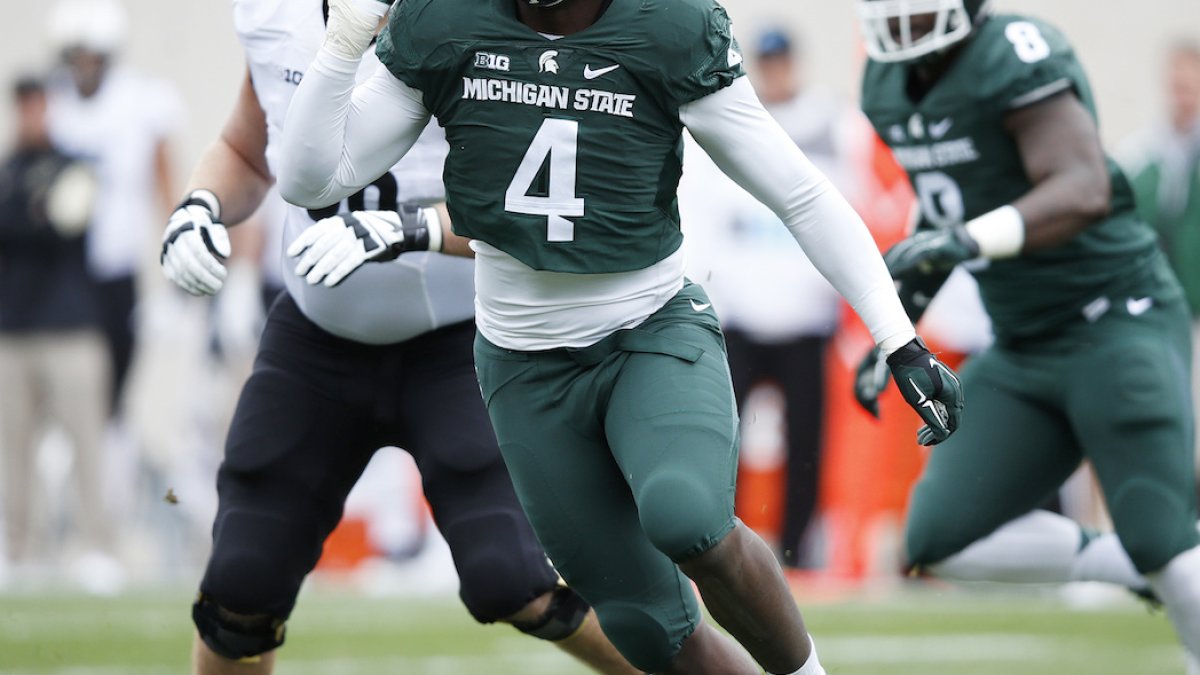With two years of college film-watching and data in the books, PFF college has the unique ability to find production trends and make player comparisons based not just on physical traits, but also on statistical tendencies.
Throughout the summer we’ll take a look back at the college's best players from 2015 and attempt to find similar players ready to produce on a comparable level this coming season. Today’s focus will be on Malik McDowell — one of the best returning defenders in the Big Ten — and how he compares to newly-drafted DeForest Buckner.
Grades and measureables
Buckner had a strong junior season in Oregon. He posted 44 defensive stops (10 against Washington in week six), 47 total pressures (at least four in five separate games) and the eighth-highest grade among all defensive interior players in FBS in 2014.
Buckner’s 2014 game grades:
While 2014 was an excellent year, his production absolutely exploded in 2015, as he ran away with our top defensive interior grade by posting 49 stops, 72 pressures (including 28 combined sacks and hits) and finished in the top five in both run stop percentage and pass rush productivity for 3-4 defensive ends. The San Francisco 49ers selected him seventh overall, verifying his status as one of the elite players of the 2016 NFL draft.
Michigan State defender Malik McDowell had a sophomore campaign comparable to Buckner’s 2014. Last season, he posted 22 stops, 39 total pressures and finished 10th in our defensive interior grades among FBS players returning for 2016.
McDowell’s 2015 game grades:
The similarities between the two don’t end with their underclassman grades. While he plays inside at defensive tackle in Michigan State’s 4-3 defense as opposed to Buckner’s 3-4 end position at Oregon, McDowell physically looks like the new 49er as well, as he is listed at 6-6 and 286 pounds (compared to Buckner, who measured 6-7 and 291 pounds at February’s scouting combine), and appears to have similar arm length (Buckner’s measured 34 3/8 inches, whereas an average arm length for a defensive lineman is around 33 inches).
Side-by-side film study
While comparing grade tracks and body types can be extremely useful, ultimately the film is the true test of a comparison. In the case of McDowell versus Buckner, they match up extremely well in this regard.
McDowell excels at shedding one-on-one blocks. He uses his arm length and upper body strength well to set up a variety of moves, and can defeat multiple layers of blocking, particularly on the pass rush.
Buckner beats blockers in a similar manner, and while both lack the closing burst to consistently finish sacks, it’s their ability to compromise plays at the line of scrimmage that makes them such destructive forces.
While both players win in a similar fashion, they also struggle in comparable ways. Although their size and length can make it extremely difficult for blockers to get into their frames when they fire off correctly, when not using proper leverage both can struggle to get off blocks.
McDowell’s film is littered with him struggling with double teams, particularly when lined up shading the center as a 1-technique.
This clip clearly highlights how his large frame can be an inhibitor, as it makes him a big target and presents him with problems when he needs to be able to anchor and hold his ground at the point of attack.
Buckner had the benefit of moving all over the Oregon defensive front, which made it tougher to key on him, but it was coincidentally against Michigan State where he showed some of the same issues with his height, leverage and lower body strength as McDowell.
Buckner was able to overcome this issue by generally being quicker than the man across from him, and using his length to his advantage by initiating contact and keeping blockers from locking on. These are skills McDowell clearly possesses, but needs to become more consistent with. While Buckner was already a solid run defender in 2014, McDowell last year wasn’t nearly as productive in this phase (he ranked 49th in FBS in 2015 on run stop percentage).
Bottom line
With Michigan State having so little experience on the defensive line this year, McDowell reportedly lost weight in order to prepare himself to be moved all over the defensive front (similar to how Buckner was utilized at Oregon last year). Hopefully this leads him away from the double teams he saw while playing out of position last season, as he is much better equipped to take on singular blockers, in particular against the run.
The Spartans’ lack of experience and depth is likely to significantly increase his snap count this year. McDowell played 636 snaps last year (up from 237 in 2014), as opposed to Buckner, who played more than 950 snaps each of the last two seasons. This is also likely to help his production significantly from a pure volume-sense, and his weight loss will hopefully allow him to maintain his conditioning.
McDowell has all the physical tools to play this season at the caliber Buckner did last year, and the deeper his film and past production is delved into, the more likely it appears Michigan State’s star defender is headed in that direction.








 © 2025 PFF - all rights reserved.
© 2025 PFF - all rights reserved.